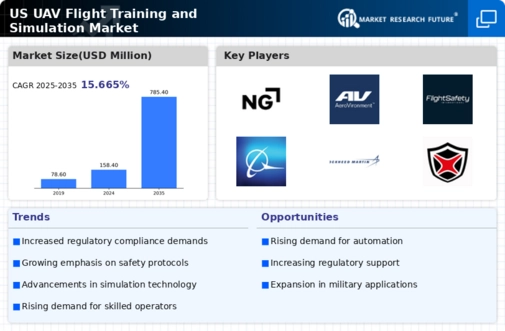Regulatory Framework Evolution
The evolving regulatory framework surrounding UAV operations is a critical driver for the uav flight-training-and-simulation market. As regulatory bodies implement stricter guidelines for UAV usage, the need for compliant training programs becomes paramount. Organizations must ensure that their operators are well-versed in the latest regulations to avoid penalties and ensure safety. The Federal Aviation Administration (FAA) has been actively updating its regulations, which has led to an increased focus on training that aligns with these standards. This regulatory evolution is likely to create a robust demand for training solutions that address compliance, thereby propelling growth in the uav flight-training-and-simulation market.
Advancements in Simulation Technology
Technological advancements in simulation technology are significantly influencing the uav flight-training-and-simulation market. High-fidelity simulators that replicate real-world flying conditions are becoming increasingly accessible, allowing trainees to gain practical experience without the risks associated with actual flight. These simulators provide a cost-effective training solution, reducing operational costs for training organizations. The market for UAV simulators is expected to reach approximately $1.5 billion by 2026, reflecting a compound annual growth rate (CAGR) of around 10%. This growth is indicative of the industry's shift towards more sophisticated training methodologies that enhance learning outcomes and operational readiness, thereby driving the uav flight-training-and-simulation market forward.
Increased Demand for Skilled Operators
The The UAV flight-training-and-simulation market is experiencing a surge in demand for skilled operators., driven by the expanding applications of UAVs across various sectors. Industries such as agriculture, construction, and logistics are increasingly adopting UAV technology, necessitating a workforce proficient in UAV operations. According to recent data, the demand for UAV pilots is projected to grow by over 15% annually through 2027. This trend indicates a pressing need for comprehensive training programs that equip individuals with the necessary skills to operate UAVs safely and effectively. As organizations seek to enhance operational efficiency and reduce costs, the The market is positioned to benefit from this growing demand for skilled personnel..
Integration of AI and Machine Learning
The integration of artificial intelligence (AI) and machine learning technologies into UAV training programs is reshaping the uav flight-training-and-simulation market. These technologies enable personalized training experiences, adapting to the individual learning pace and style of each trainee. AI-driven analytics can assess performance in real-time, providing immediate feedback and enhancing the learning process. As organizations increasingly recognize the benefits of AI in training, the market for AI-enhanced UAV training solutions is expected to grow significantly. This trend suggests a shift towards more efficient and effective training methodologies, which could potentially increase the overall competency of UAV operators in the field.
Growing Investment in Defense and Security
The growing investment in defense and security sectors is a substantial driver for the uav flight-training-and-simulation market. Governments are increasingly allocating funds towards enhancing their UAV capabilities for surveillance, reconnaissance, and combat operations. This trend is reflected in the projected defense spending, which is expected to rise by approximately 5% annually over the next few years. As military organizations seek to improve their UAV operational effectiveness, there is a corresponding need for advanced training programs that prepare personnel for complex UAV missions. This investment in defense and security is likely to bolster the uav flight-training-and-simulation market, creating opportunities for training providers to develop specialized programs tailored to military applications.




















Leave a Comment